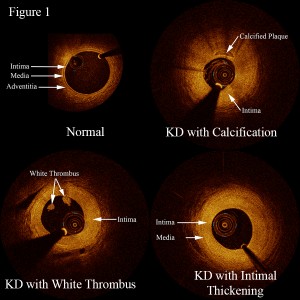Dr. Anas Manouzi, Year 2 Resident, won the Best Resident Research Paper and will represent the Department of Pediatrics at the 26th Annual National Pediatric Resident and Fellow Research Competition in Winnipeg, Manitoba, on May 15, 2014.
Optical Coherence Tomography Identifies Coronary Abnormalities in Children
Anas Manouzi, M Hosking, A Fung, A De Souza, J Potts, K Harris [Division of Cardiology]
Background: Optical Coherence Tomography (OCT) is a high-resolution intravascular imaging technique used in adults. We tested the hypothesis that OCT could identify coronary abnormalities not seen by angiography in children with a history of Kawasaki Disease (KD) and pediatric heart transplant (TX) recipients.
Methodology: KD patients and TX recipients were evaluated between December 2012 and October 2013 with angiography and OCT (Ilumien System, LightLabs, St Jude Medical, Westford, MA). Modifications were made to the adult OCT protocol to adapt this technique for children. Serial cross sectional area (CSA) measurements of the lumen, intima and media were made. Entire imaging data was analyzed for the presence of qualitative changes.
Results: Seventeen children were evaluated (5 KD patients; 12 TX recipients). In KD patients angiography was normal. The lumen area was normal (z-score >-2 and <+2) at 95% of the 86 data collection points. However, significant vessel wall abnormalities were present in all children including intimal thickening (intima/lumen CSA ratio > 0.4), loss of the normal layered structure of the vessel wall, white thrombus, calcification and neovascularization. There was extensive destruction of the internal elastic lamina. In TX recipients angiography was normal; however, intimal thickening [intima/media (I/M) CSA ratio >1] was seen in 9/12 patients. The median I/M CSA ratio was 1.18.
Conclusion: In this initial experience with OCT in children, we have shown significant abnormalities in the coronary arteries of children with a history of coronary aneurysms due to KD and TX recipients that are not identified with conventional angiography.
Many thanks to Dr. Jean-Paul Collet, Celebrate Pediatric Research Day Program Chair and our Research Paper Competition Judges: Dr. Clara van Karnebeek, Dr. Kyla Hildebrand, and Dr. Connie Yang
